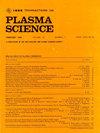Influence of Armature/Rail Structure Coordination on the Evolution of Rail Deposition Layer
IF 1.3
4区 物理与天体物理
Q3 PHYSICS, FLUIDS & PLASMAS
引用次数: 0
Abstract
During the launch of the railgun, the interface of the armature/rail (A/R) will undergo severe melting and wear. The molten armature material will further solidify and deposit on the surface of the rail to form an aluminum deposition layer, which will change the original contact state and affect the subsequent armature launch performance. The evolution of the deposition layer under flat rails and D-shaped rails was experimentally studied. The study found that the deposition layer presents a changing trend of thickness on both sides and thin in the middle. With the increases in the number of experiments, the thickness of the deposition layer gradually accumulates, however, in the end, the thickness of the deposition layer tends to stabilize. Experiments have found that the horizontal distribution of the D-shaped rail deposition layer is more uniform than that of the flat rail, and the increase rate of the thickness of the deposition layer is lower than that of the flat rail. Based on the analysis of the A/R contact resistance and current density distribution, we have given an explanation for the difference in the thickness distribution of the deposition layer. In addition, the thickness of the deposition layer tends to be stable under the two rail conditions because the bond strength of the deposition layer and the rail decreases after repeated launch, and the tensile stress increases, which leads to the peeling off of the deposition layer.电枢/轨道结构协调对轨道沉积层演变的影响
在轨道炮发射过程中,衔铁/导轨(A/R)界面会发生严重熔化和磨损。熔化的电枢材料会进一步凝固并沉积在轨道表面,形成铝沉积层,从而改变原有的接触状态,影响后续的电枢发射性能。实验研究了平面导轨和 D 型导轨下沉积层的演变过程。研究发现,沉积层呈现出两边厚、中间薄的变化趋势。随着实验次数的增加,沉积层厚度逐渐累积,但最终沉积层厚度趋于稳定。实验发现,D 形钢轨沉积层的水平分布比平面钢轨更均匀,沉积层厚度的增加率比平面钢轨低。基于对 A/R 接触电阻和电流密度分布的分析,我们给出了沉积层厚度分布差异的解释。此外,在两种轨道条件下,沉积层厚度趋于稳定,这是因为沉积层与轨道的结合强度在反复发射后会降低,拉应力增大,从而导致沉积层剥落。
本文章由计算机程序翻译,如有差异,请以英文原文为准。
求助全文
约1分钟内获得全文
求助全文
来源期刊

IEEE Transactions on Plasma Science
物理-物理:流体与等离子体
CiteScore
3.00
自引率
20.00%
发文量
538
审稿时长
3.8 months
期刊介绍:
The scope covers all aspects of the theory and application of plasma science. It includes the following areas: magnetohydrodynamics; thermionics and plasma diodes; basic plasma phenomena; gaseous electronics; microwave/plasma interaction; electron, ion, and plasma sources; space plasmas; intense electron and ion beams; laser-plasma interactions; plasma diagnostics; plasma chemistry and processing; solid-state plasmas; plasma heating; plasma for controlled fusion research; high energy density plasmas; industrial/commercial applications of plasma physics; plasma waves and instabilities; and high power microwave and submillimeter wave generation.
 求助内容:
求助内容: 应助结果提醒方式:
应助结果提醒方式:


